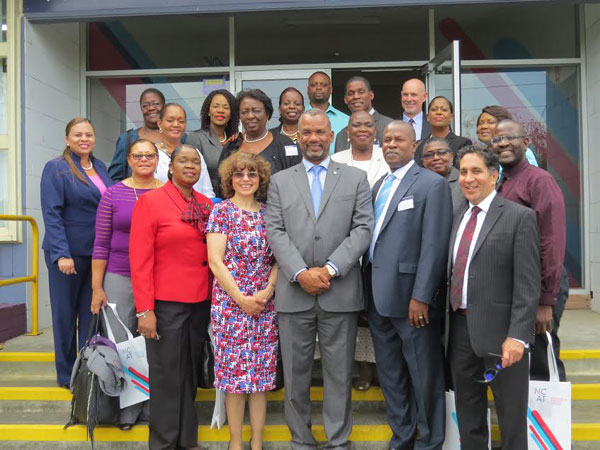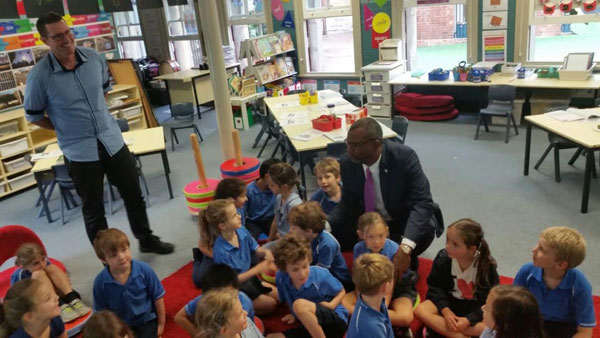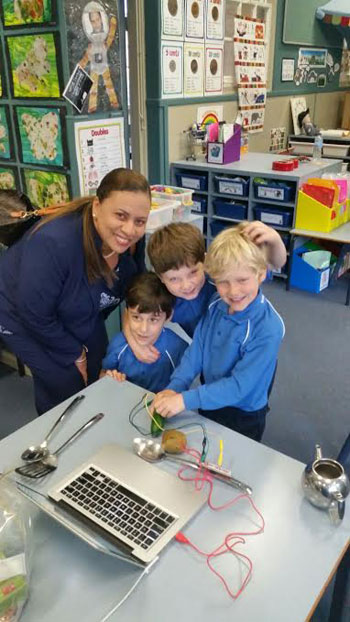|

|
 |
|
Last Updated: Feb 13, 2017 - 1:45:37 AM |
Minister of Education, Science and Technology and senior education officials learn what makes a successful school system during a trip to Australia

Group photo of study-visit participants
|
Nassau, Bahamas – Since assuming office as Minister of Education, Science and Technology in 2012, the Hon. Jerome K. Fitzgerald embarked on an initiative to participate in study-visits to countries renowned for prominent education systems. Leading senior education officials on the last fact finding and observation trip of countries considered to have the top education systems, the delegation travelled to the other side of the world to New Zealand and Australia to meet with education officials of those neighbouring countries.
Countries previously visited include Finland, Canada, and Singapore, all considered global education super-powers. Minister Fitzgerald touts that one of the most comforting take-aways from all of the trips is the fact that we have more right than wrong. “When we observed many of the components of the different countries, in terms of curriculum, teachers, resources etc. we resemble many of these countries. I think the biggest difference is cultural and the national emphasis that is placed on the value of education. After one of my trips, I think to Singapore, I coined the phrase education must become a core value not just a priority. As a country, we must place greater emphasis on the value of education and its multiple benefits; our citizens must come to realize that everything begins and ends with education; particularly the growth and development of our economy and country.”

Minister engages with primary school students
|
During the trip to Australia, one of the many topics discussed was the structures that make for a successful school system. There were five areas identified as critical for an overarching effective education system. Among them were: teacher capacity, leadership capacity, focus on closing the achievement gaps, focus on capacity building and multiple pathways for student success.
The Australian education system believes that teacher capacity is paramount. ‘The most successful school systems recognize that school systems cannot exceed the capacity of its teachers and are therefore focused (with precision) on developing a highly skilled teaching force. Skilled teaching has many facets, but three dominate the discussion: 1. Content knowledge, 2. Pedagogical knowledge, 3. Interpersonal/cultural skills.’
To compliment the capacity of teachers, another key enabling factor is leadership capacity: ‘No school deemed high performing has ever achieved its status without high quality leadership. School Principals are highly autonomous, hiring own staff, managing his/her own budget, truly acting as the CEO of the School. This highly evolved role of on-site school leadership creates a highly accountable structure - removing the ability for schools to hide behind bureaucracy. It is suggested that high levels of devolution can only be successful where there are corresponding high levels of professional capacity. It is also noted that a high quality of leadership cannot be deemed to exist where there is not a corresponding high level of student achievement.’

Assistant Director of Education, Keyshan Bastian with Australian Students
|
Around the world, there is a renewed focus on closing the achievement gaps: ‘Successful school systems focus on closing the achievement gaps. This focus works best when there is a systemic expectation that ALL students can achieve rigorous standards. Achievement gaps typically exist among key student groups: marginalized students (immigrants, English Language learners, students with disabilities, students from low socioeconomic backgrounds) to name a few examples. While programs may exist to support these students in their homes and communities, successful school systems never lose a concomitant focus on high levels of engagement and student achievement.’
Another pillar in building a strong school system is focusing on capacity building: ‘Building capacity is a multi faceted undertaking. It works best when it happens in both traditional and non-traditional ways. There are any number of opportunities for teachers to engage in professional courses and training programs. This is underpinned by a strong teacher training program which is focused on reducing the shock of new entrant teachers into active teaching roles. Additionally, there are other well researched mechanisms at play which bolster collegiality and the sharing of best practice e.g., Professional Learning Communities, as well as Learning Networks - which when implemented well should reduce both inter and intra school variability.’
The final prong of a successful school system is the provision of multiple pathways for student success: ‘A key feature of Victoria’s education system and of Australia’s at large – is its remarkable commitment to answering the question, “How are students smart?” Victoria provides a number of pathways for students to maximize their learning potential – through academic pathways, career and technical pathways, arts and technology pathways, or a combination thereof! Students are able to engage in the education system at a point that best suits them. Failure at any point does not count the student out. They are able to re-engage in the education system with appropriate supports that gets them to their end goals! The various schools visited illustrated the operationalization of this commitment for diverse learners.’

|
Many of the participants indicated that one of the impressive observations was at the primary school level and what is known as ‘Modern Learning Environments’ or ‘Innovative Learning Spaces’. These are ‘learning environments that align better with what we know about the brain and student learning can facilitate traditional pedagogies such as direct instruction if needed, but they typically offer students and teachers much more. The components of a modern learning environment include:
-
Flexibility: the ability to combine two classes into one for team-teaching, split a class into small groups and spread them over a wider area or combine different classes studying complementary learning areas.
- Openness: modern learning environments traditionally have fewer walls, more glass and often use the idea of a learning common (or hub) which is a central teaching and learning space that can be shared by several classes. They provide opportunities to observe and learn from the teaching of others and be observed in return. They also provide access to what students in other learning areas and level are learning, so that teaching and learning can be complemented and enhanced.
- Access to resources (including technology): typically the hub is surrounded by breakout spaces allowing a range of different activities, such as reading, group work, project space, wet areas, reflection, and presenting. There is often a mixture of wireless and wired technology offering access as and when students need it, within the flow of their learning.
Overall, learning environments are designed to support student learning. According to research “many of the modern learning environments being built today effectively promote and support a range of pedagogies including delivering, applying, creating, communicating and decision-making. Often they are centred around a student’s ‘home base’ where a lot of the teaching and learning occurs but these bases also allow access to other learning spaces. Not all classes will need all spaces all of the time, but students should have access to them should the need arise. Modern learning environments support strengths-based teaching. For example, two classes collaborating on a science project that requires them to publish what they’ve learnt in the form of an educational poster will achieve much better results if both classes have access to one teacher who has considerable skill in graphic design and one teacher who has excellent knowledge of science and scientific inquiry.”
As the Ministry of Education, Science and Technology has implemented The Bahamas High School Diploma to standardize high school education throughout the country, trips like this help to solidify the work already underway in ensuring that we offer ‘quality education for equitable development: performance, paths and productivity’. These trips have allowed Ministry of Education officials and education stakeholders to glean best practices from countries that have well-established and effective high school diploma programmes. The first cohort of the Bahamas High School Diploma (BHSD) are currently in their second year as 11th graders and will be the first to graduate with a BHSD in 2017.
The Minister along with BTVI’s Acting President, Deputy Directors, Assistant Directors, District Superintendents and members from the Anglican Education Authority as well as the Catholic Board of Education all touted the trip as an insightful learning experience. They are all optimistic that The Bahamas is on the right track and that with a national commitment to education, we can accomplish the goals needed to bring about the necessary improvements in our education system.
Each citizen has a role to play in this process and we must realize that “education is everyone’s business”. The future of our country depends on our collective effort to instill the value of an education in our students from preschool and beyond and foster lifelong learning that will continue well after high school graduation.

© Copyright 2015 by thebahamasweekly.com
Top of Page
|
|
 |

|
